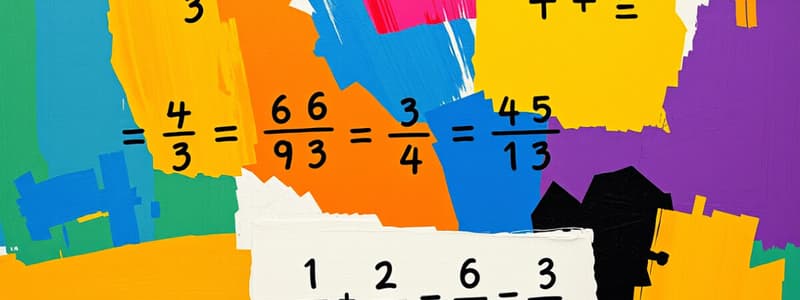Podcast
Questions and Answers
Which statement accurately defines rational numbers?
Which statement accurately defines rational numbers?
- Rational numbers can be expressed as fractions with non-zero denominators. (correct)
- All numbers are considered rational numbers.
- Rational numbers only include whole numbers.
- Rational numbers cannot be expressed as fractions.
When adding rational numbers, what must be done first?
When adding rational numbers, what must be done first?
- Add the integers directly.
- Multiply the denominators together.
- Find a common denominator. (correct)
- Convert all numbers to decimals.
Which of the following fractions is in its simplest form?
Which of the following fractions is in its simplest form?
- $\frac{9}{27}$
- $\frac{4}{8}$
- $\frac{2}{5}$ (correct)
- $\frac{12}{16}$
In which of the following scenarios would rational numbers NOT typically be used?
In which of the following scenarios would rational numbers NOT typically be used?
What is the result of simplifying the fraction $\frac{18}{24}$?
What is the result of simplifying the fraction $\frac{18}{24}$?
Which operation involves multiplying by the reciprocal?
Which operation involves multiplying by the reciprocal?
How are positive rational numbers positioned on a number line?
How are positive rational numbers positioned on a number line?
Which of the following could represent a rational number?
Which of the following could represent a rational number?
Flashcards are hidden until you start studying
Study Notes
Definition Of Rational Numbers
- Rational numbers are numbers that can be expressed as the quotient or fraction ( \frac{p}{q} ), where:
- ( p ) is an integer (positive or negative).
- ( q ) is a non-zero integer.
- Examples include: ( \frac{1}{2}, -3, 0.75 ) (which is ( \frac{3}{4} )).
- All integers, finite decimals, and repeating decimals are rational numbers.
Operations With Rational Numbers
- Addition:
- To add rational numbers, find a common denominator, then combine the numerators.
- Subtraction:
- Similar to addition; find a common denominator, then subtract the numerators.
- Multiplication:
- Multiply the numerators together and the denominators together: ( \frac{a}{b} \times \frac{c}{d} = \frac{ac}{bd} ).
- Division:
- Multiply by the reciprocal: ( \frac{a}{b} \div \frac{c}{d} = \frac{a}{b} \times \frac{d}{c} ).
Simplifying Rational Numbers
- Simplification involves reducing the fraction ( \frac{p}{q} ) to its lowest terms:
- Find the greatest common divisor (GCD) of ( p ) and ( q ).
- Divide both the numerator and denominator by their GCD.
- Example: ( \frac{12}{16} ) simplifies to ( \frac{3}{4} ).
Real-life Applications Of Rational Numbers
- Financial transactions (e.g., budgeting, prices).
- Measurement (e.g., cooking recipes, distances).
- Probability (expressing likelihood as fractions).
- Statistics (data representation, averages).
Rational Numbers On The Number Line
- Rational numbers can be plotted on a number line:
- Each rational number corresponds to a specific point.
- Positive rational numbers are to the right of zero, negative rational numbers are to the left.
- The distance between points can be divided into equal parts, representing fractional values.
Definition Of Rational Numbers
- Rational numbers can be expressed as a fraction ( \frac{p}{q} ) where ( p ) is an integer and ( q ) is a non-zero integer.
- Examples include fractions like ( \frac{1}{2}, -3 ) and decimal ( 0.75 ) (equivalent to ( \frac{3}{4} )).
- All integers, finite decimals, and repeating decimals qualify as rational numbers.
Operations With Rational Numbers
- Addition:
- Requires a common denominator; combine numerators after alignment.
- Subtraction:
- Follows the same principle as addition; find a common denominator to subtract numerators.
- Multiplication:
- Perform by multiplying the numerators and multiplying the denominators: ( \frac{a}{b} \times \frac{c}{d} = \frac{ac}{bd} ).
- Division:
- Achieved by multiplying by the reciprocal: ( \frac{a}{b} \div \frac{c}{d} = \frac{a}{b} \times \frac{d}{c} ).
Simplifying Rational Numbers
- Simplification reduces ( \frac{p}{q} ) to its lowest terms by:
- Finding the greatest common divisor (GCD) of ( p ) and ( q ).
- Dividing both the numerator and denominator by their GCD.
- An example is ( \frac{12}{16} ) simplifying to ( \frac{3}{4} ).
Real-life Applications Of Rational Numbers
- Used in financial transactions for budgeting and setting prices.
- Important for measurements in cooking recipes and determining distances.
- Expresses probability as fractions indicating likelihood.
- Utilized in statistics for data representation and calculating averages.
Rational Numbers On The Number Line
- Rational numbers are represented on a number line, where each number corresponds to a specific point.
- Positive rational numbers are located to the right of zero, while negative ones are to the left.
- The segments between points on the line can be evenly divided, indicating fractional values.
Studying That Suits You
Use AI to generate personalized quizzes and flashcards to suit your learning preferences.




